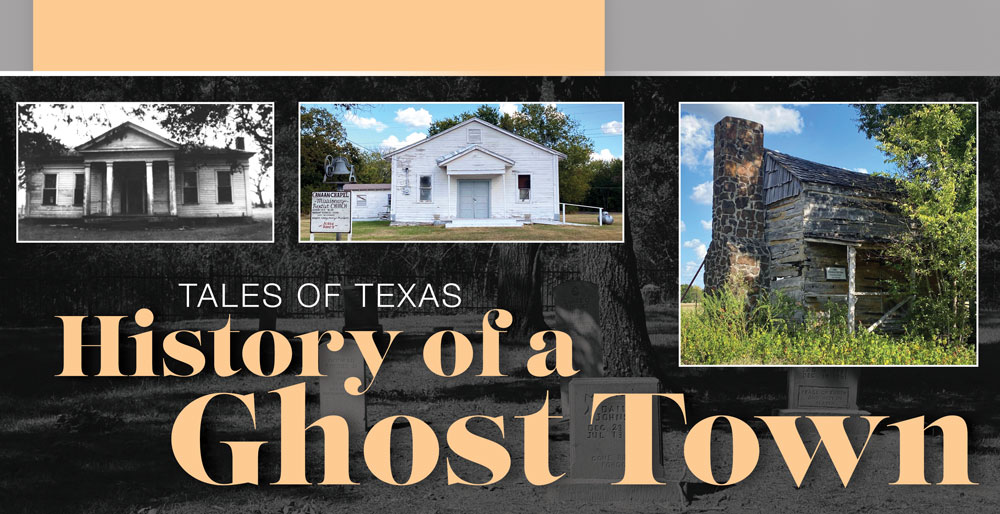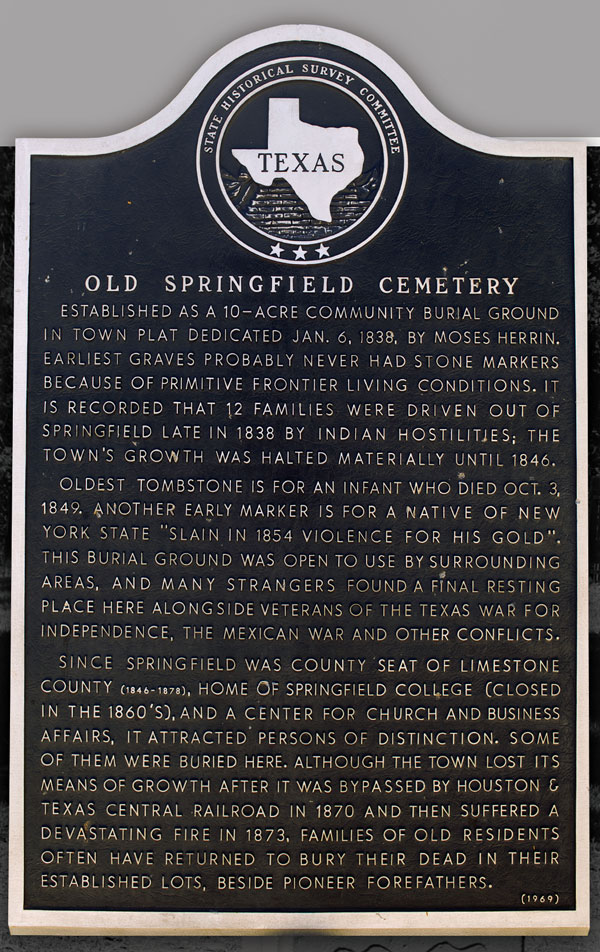
The Limestone County Historical Commission website indicates that the Springfield Cemetery, located within the boundaries of Fort Parker State Park, is the only visible reminder of the town of Springfield, the first county seat of Limestone County. The cemetery would be “in the middle of nowhere” today, were it not for its proximity to the park.
Near Fort Parker is the 1830s cabin of one Mordecai Yell. A plaque on the cabin shows the house was originally located “near this site,” and it is probably the only remaining structure that may have been in the city of Springfield.
A photograph of another structure exists, known as Pleasant Retreat Plantation House or Stroud Ranch House. Built just 20 years after the first Anglo-American settlers came to the area and built Fort Parker, the house existed until 1944. For the time period, it was a significant house and was built for Logan Stroud and his father, Ethan Stroud, who came to the Republic of Texas in 1837. The family had considerable wealth and owned plantations in several counties. By the time of the Civil War, Logan was one of the largest slave holders in the county.
A History of Limestone County by Ray A. Walter records that The Emancipation Proclamation was read in Limestone County from the portico of Pleasant Retreat on Saturday, June 19, 1865. This was the same day the Union soldiers arrived in Galveston to first proclaim the news of freedom in Texas. This opened the door to former slaves for new opportunities, including property ownership, and they had new political and social influence in the community. Today, the significance of Juneteenth, as the day became known, has been nationally recognized, with the 117th Congress voting to make it a federal holiday in 2021.
The city of Springfield certainly had its share of ups and downs. By 1850, it was the largest city between Dallas and Houston, and according to the Limestone County Historical Commission’s website, it was home to five general mercantile stores, two taverns, two groceries, two blacksmiths, two tailors, a carpenter, a gunsmith, a hotel, a wagon maker, a teacher, four physicians, three Methodist preachers, a surveyor and three lawyers. George W. Baines was a Baptist preacher who traveled to Springfield and was later a president of Baylor University. He was also the great-grandfather of Lyndon Baines Johnson, the 36th president of the United States.
There was a racetrack on land just north of the town. Two log structures were built in 1844 and 1847 to house the school, and by 1856, a larger schoolhouse was built. In 1857, the first brick courthouse was constructed in Springfield’s public square. By 1860, more businesses and professionals called the thriving town home, and Springfield College was the pride of area residents.

When the Civil War broke out, more than three-quarters of Limestone County’s voting population served in the Confederate Army. Businesses closed — some temporarily and some permanently — including the college, which closed permanently in 1863.
After the war, many of the survivors returned, but Reconstruction was difficult. Former Confederates no longer had the power and privileges they had before the war, including the rights to vote and bear arms. There was much civil unrest in the county, and the governor placed the county under martial law for a time during 1871.
This was just about the time that the Houston and Texas Central Railroad was ready to come through after landowners had donated right-of-way in the early 1860s. Leading citizens in Springfield convinced the property owners to withdraw their offers and force the railroad to purchase their land. While the railroad was willing to negotiate for a fair price, most of the property owners asked unreasonably excessive amounts. The railroad obtained the right-of-way that they needed about three miles east of Springfield, leading to the demise of the community.
The last straw was when the county courthouse burned in 1873. Many of the county records were destroyed by the fire, and those that weren’t were moved to another commercial building that also burned just five months later, destroying all of the records. Arson was suspected in both fires.
As white residents moved to Groesbeck and Mexia, people deconstructed the wooden buildings in Springfield and rebuilt them in their new locations. Little was left of Springfield, but a number of Freedmen remained, and the former county seat became one of the leading African-American communities in the county. According to the Limestone County Historical Commission, a Freedman named Ralph Long, who served as a delegate to the state Constitutional Convention of 1868-1869, “served on the committee for education and was later responsible for establishing a school for black children that operated in Springfield until the mid-1940s.” By the time Fort Parker State Park was established in the 1930s, nothing remained of the town, except the cemetery.
References:
1. Thc.texas.gov.
2. HABS No. TX-3492 Historic American Buildings Survey, National Parks Service, U.S. Department of Interior.
3. Limestonechc.com/cemetery-preservation/springfield-cemetery.
Written by Bill Smith

You must be logged in to post a comment.